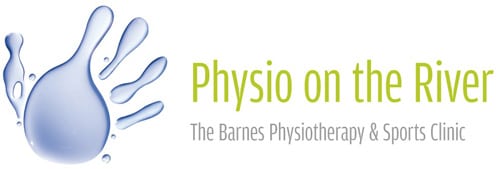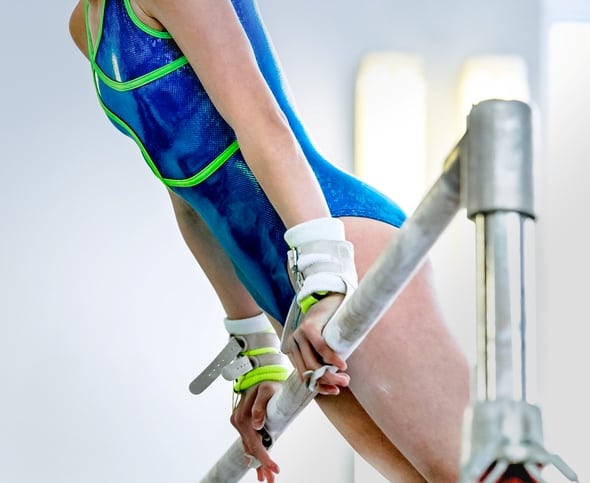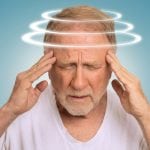Do you have a gymnast in the family complaining of aches and pains?
Do you have a gymnast in the family? And are they frequently complaining of aches and pains?
As a parent it’s often hard to know how much to worry about your child’s injuries.
We are used to children getting cuts and bruises in the normal course of play and they usually bounce back very quickly.
We have asked Katherine Ashmore, one of our team of musculo-skeletal Physiotherapists, to explain a little more about why children and teenagers are different from adults and what you should look out for if your child gets injured.
Katherine is an ex-gymnast herself so she knows all about the demands of the sport. She has a special interest in helping children and adults recover from gymnastic injuries. She can also help with screening to identify areas of weakness and potential injury risk.
How are children’s skeletons different from adult’s?
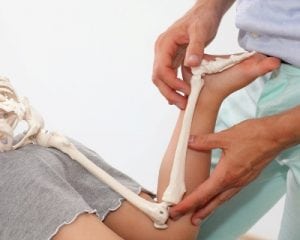
Presentation of childs lower limb skeletal system
The way children’s bodies react to injury can be very different to that of an adult, especially when they are going through a growth spurt.
Sometimes what you think is nothing more than a muscle ache might be something more – especially if your child is specialising early in gymnastics where the demands on the body are high.
The immature skeleton contains growing tissue that is not present in an adult – so they shouldn’t be regarded as a ‘mini-adult’.
Growth spurts
Children go through two growth spurts – one around the age of 6 to 8 years old and the other more major one is during puberty. This can start at about age 10-12 in girls and around age 13-14 in boys.
Their skeletons are not fully formed until they have gone through puberty. This is about 15-16 years for girls and 18-19 for boys (and sometimes as late as 21-22 years) – when they finally stop growing.
How do I tell if it’s just growing pains?
Growing pains are a recognised condition and are typically:
- felt more in the legs below the knees
- experienced by boys and girls equally
- symmetrical although they can be worse in one leg
- rarely cause the child to limp
- felt only at night and intermittently
- not brought on by an injury
Hypermobility
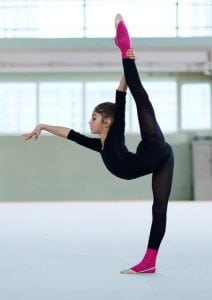
gymnast demonstrating hypermobility
Another factor that makes children who get into gymnastics a bit more susceptible to injury is that they are often hypermobile – or, in plain language, double jointed!
They can have one or two isolated joints that are extra bendy or they may have multiple joints affected which is called hypermobility syndrome.
It is often this increased flexibility that attracts them to the sport in the first instance and makes them excel at it.
The demands of the sport
The nature of the sport involves very repetitive actions and extremes of joint movement.
In the young competitive world of gymnastics children have high training schedules making them susceptible to overuse injuries.
Types of injuries
The most common gymnastic injuries are in the wrist, back, knee and ankle. This can be due to the explosive force of power put through the arms and legs on push off and landing.
Commonly gymnasts have a higher incidence of soft tissue injuries (muscle and ligament strains, sprains and dislocations) and bone fractures. Landing awkwardly is often a cause of these injuries – for example affecting shoulder muscles or ligaments when landing on your hands, or causing an ankle sprain when landing awkwardly on your feet.
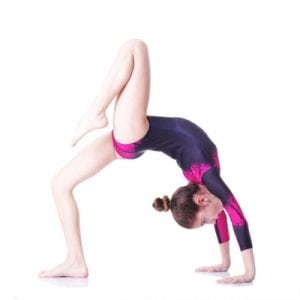
floor exercises
Certain types of gymnastic disciplines may give more problems than others – with the vault, uneven bar, balance beam, pommel horse and floor exercises having the highest incidence of injury.
5 good reasons why a young gymnast should consult a Physio
- Suffering from lower back pain: this tends to be more common in girls and in those with poor core stability. Pain is commonly due to repeated hyperextension (over-arching of the lower back). In extreme cases this repeated hyperextension can cause a Spondylolithesis (a small bony stress fracture in the spine) which often goes undetected until the child is seen by a physiotherapist.
- Knee pain felt in children in their early teens can sometimes be due to a condition called Osgood Schlatter’s disease. This is where the quads muscle attaches via a tendon onto a bump of bone under the knee called the tibial tubercle. This bump is a centre of bone growth called an apophysis. When teenagers put on a sudden growth spurt this junction between tendon and growing bone can become stressed and painful.
- Hypermobility can make children more susceptible to injury but Physio can help by identifying the problem and showing them how to manage this condition by strengthening their supporting muscles. So if your child seems to complain of frequent aches and pains it would be worth having them assessed by one of our Physios.
- Poor core stability: we don’t really know when children gain good core control (muscular control around their back and stomach) but we often surprisingly observe poor core stability in children doing quite high level sport. This lack of strength around their middle can also raise their risk of injury. Exercises can help them to restore this strength.
- A simple sprained ankle: spraining your ankle is always seen as a relatively minor injury but we know that unless the ankle is properly rehabilitated recurrent problems can occur. In children instead of simply straining the ligament they can sometimes pull off a small piece of bone from the ankle bone as well
How Physio can help
So in summary, we can help by assessing your child to:
- rule out hypermobility or teach your child to manage it
- identify any weaknesses that may lead to injury and set a programme of exercises to work on them
- by treating any injury that may occur whilst screening for anything more serious.
To book an appointment with Katherine or one of our Physio team:
Call 0208 876 5690
Email us here
Pop in for a chat or book online here!
